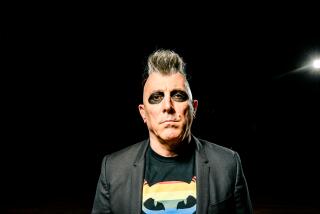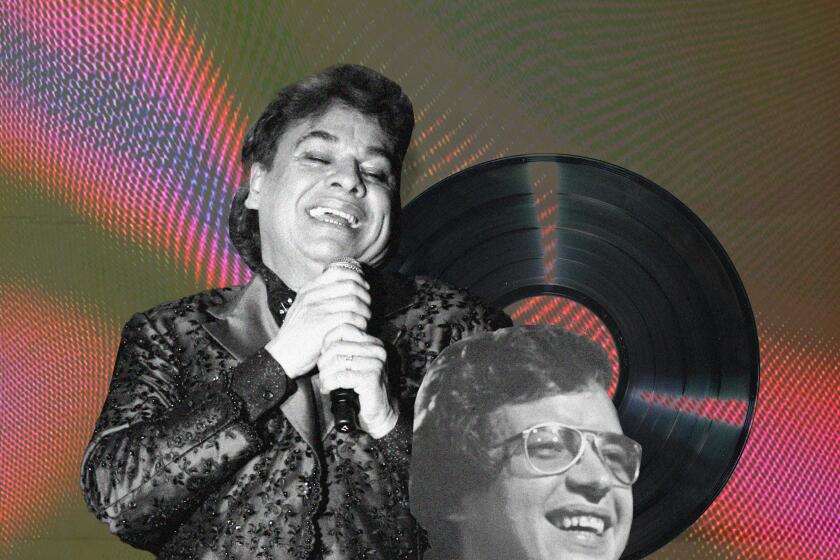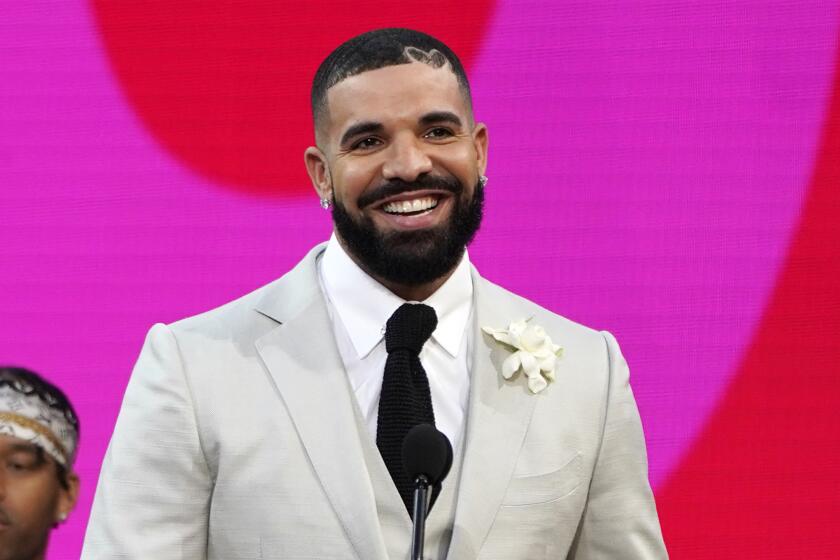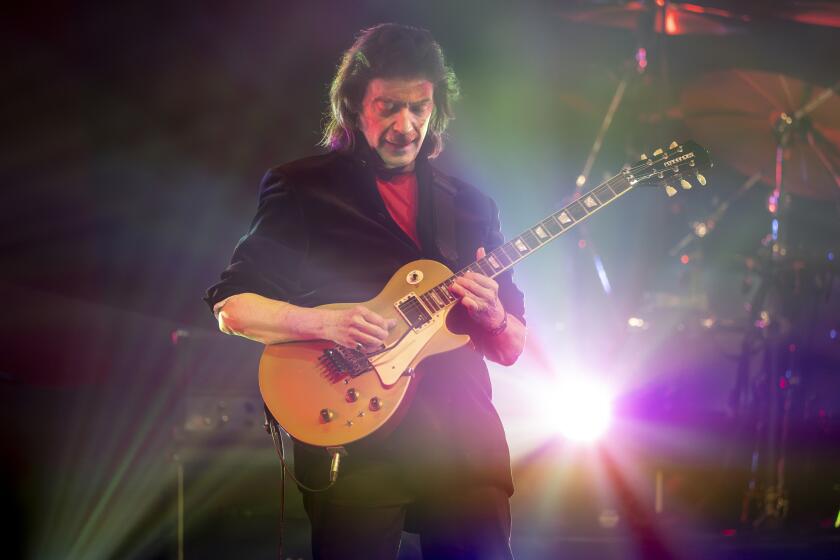In glorious disarray
Anyone who’s ever been to Coachella or any music festival understands the idea of “the moment,” that magical, jewel-encrusted feeling you get when everything clicks -- the sound, the lights, the emotion, the music -- and you feel at one with the world.
On Friday at this year’s Coachella Music and Arts Festival, a chilly night where the clouds hung low after a day of rain, Mazzy Star induced one of those arm-tingling feelings when it performed its languid, drifting love song “Fade Into You” on the Outdoor Stage.
It was one of the band’s first performances in 16 years, and it followed a day of nonstop music, including Sacramento band Death Grips’ electrifying, hard-core punk numbers, L.A. folk pop group honeyhoney’s banjo-led ode to the Los Angeles River, and Texas blues rock guitar player Gary Clark Jr.’s astounding blues riffs.
So already it was a lot to digest before Mazzy Star singer Hope Sandoval and guitarist David Roback embarked on the lonely “Fade Into You” melody. Fans on the periphery, recognizing it, jogged closer.
It’s an amazing thing to experience, the blossoming of recognition that comes when you hear something special. And it happened over and over again during Coachella’s first weekend.
I watched grown men sprint toward the main stage like kids as Brit-pop band Pulp performed its anthem “Common People” and heard a teenager giddily scream to a fan, “I know this song!” when Madness started its 1983 song “House of Fun.” French house producer SebastiAn had offered magnetic beats at the Mojave tent while dancers pushed to get closer to the stage -- and the music that was moving them.
On Sunday afternoon as the sun was starting to fade, L.A. bassist Thundercat brought his cosmic blend of funk, ‘70s fusion and modern-day beat music to the Gobi tent. Wearing a freaky leather gold and red star-man uniform and fronting a nine-piece band, he suggested a modern-day Sun Ra reincarnated with the hip-hop gene.
Coachella 2012: A visual and sonic mess that we can’t resist, one with so many spoken and unspoken messages delivered in so many subgenres that you wonder how anyone in attendance can contain it all.
Other than the simple two-word answer “You can’t,” Coachella’s first of two weekends offered a snapshot of pop music in wonderful, remarkable disarray, a Jackson Pollock of frequencies and angles, of off-shoots, reflections, of twentysomething musicians digging back to revive genres once thought extinct.
Who’d have known, for example, that alto saxophone solos and soft rock would find purchase on Coachella’s stages? Destroyer did. And when singer Jeff Mangum of the indie rock band Neutral Milk Hotel brought out a two-piece brass section for some of his songs, the crowd roared -- for the French horn part.
But these days looking back while taking baby steps forward is the way it’s done. The new normal is less about progress than about reflection.
Not that the future isn’t glorious. The retro vibe was, predictably, only one aspect of the festival’s expansive lineup.
Buzzing rapper Azealia Banks, in one of her first public performances, did something absolutely of the moment: An unknown a year ago, she dropped a hot song, “212,” on YouTube, and millions of views and a label deal later, there she was, capping her brief set with the song -- and the entire Gobi tent rapped along to every word.
It was an emotional moment. YouTube views are an abstraction; all you see is the number increasing as a clip goes viral. When Banks saw the massive crowd jumping, screaming, rapping along to her words, her voice became strained for a second and tears started rolling down her cheeks. Then, though, that voice, still young but filled with potential, grew stronger and more confident, the crowd’s enthusiasm transmitting energy that seemed to fill her lungs. It felt like some sort of christening.
One of the best hours of the festival and my musical year was Saturday night at the Gobi tent, where Los Angeles beat-maker Flying Lotus pushed forth a set of deconstructed, heavy-duty bass music -- while a big inflatable green alligator bounced around atop the crowd. Lotus’ work as a beat producer has pushed the genre in fantastic new directions, and over the last three years he’s moved from L.A. warehouse parties into an ever-expanding worldwide fan base.
And with good reason: Live, he was magnetic, bouncing before his computer and tabletop mixer and interface, creating on-the-fly remixes and freakazoid juxtapositions. At one point, he sampled an a capella version of -- all things -- Christopher Cross’ yacht rock classic “Sailing,” which he then destroyed with digital feedback. The peak was when he kicked out Jay-Z and Kanye West’s already-classic “... in Paris,” and remixed it into choppy, screwy confusion.
Many were hoping for a cameo by Radiohead’s frontman Thom Yorke, but that didn’t happen. Yorke has collaborated with Lotus, but apparently the singer had other things on his mind -- like his band’s headlining slot on the main stage.
He needn’t have worried. Having hired the best sound technicians, an expert stage designer and expert management, Radiohead has amassed a loyal following and understands how to move it. And aside from doing something mind-bafflingly misguided such as collaborating with Scott Stapp or Lady Gaga, Radiohead could keep doing this for a long time.
Over the course of two hours, the band’s magnificent presentation turned a darkened dozen acres into a five-story glowing altar of images and abstractions. These images strobed and pumped through “The Gloaming,” shifting with each bent Jonny Greenwood guitar line, drawing close to singer Yorke as he pushed a falsetto.
On “Weird Fishes/Arpeggi,” a screen of vertical light bars created what looked like an illuminated waterfall. The band -- including percussionist Phil Selway, guitarist Ed O’Brien and bassist Colin Greenwood -- helped build momentum.
Radiohead’s show was a blur of a lot of different things -- from trippy visuals to people dancing fluidly in the open air to Yorke’s moaning something about “just because you feel it, doesn’t mean it’s there” in the song “There, There.”
He may be right, but like the best music during Weekend 1 of Coachella, the stuff we felt the deepest seemed to orbit the polo fields with magnetic, invisible energy.
--
More to Read
The biggest entertainment stories
Get our big stories about Hollywood, film, television, music, arts, culture and more right in your inbox as soon as they publish.
You may occasionally receive promotional content from the Los Angeles Times.






